
Title: Using knitr and LaTeX for literate laboratory notes
Summary:
background, desiderata, and solutions for lab notes.
Full text of article: publicly available now.
Author:
Boris Veytsman
Publication: TUGboat
volume 43, number 2 (2022),
pages 130-133
DOI (this page):
10.47397/tb/43-2/tb134veytsman-labnotes
(previous doi
- next doi)
Category:
Software & Tools
Difficulty: Intermediate
Abstract:
LaTeX allows the production of detailed laboratory notebooks, that
can be easily read, searched and indexed. The addition of
knitr helps to integrate the notebooks with the inclusion of
typeset code and its output, such as plots, tables, etc.
References:
- R. Fairman. FigPut. Interactive Figures for LaTeX, 2022. ctan.org/pkg/figput
- A. Grahn. The animate package, 2022. ctan.org/pkg/animate
- A. Grahn. The media9 package, v1.24, 2022. ctan.org/pkg/media9
- J. Gruber. Markdown, 2004. daringfireball.net/projects/markdown/
- C. Heinz, B. Noses, J. Hoffmann. The Listings Package, 2020. ctan.org/pkg/listings
- H.M. Kanare. Writing the laboratory notebook. American Chemical Society, Washington, D.C, 1985.
- T. Kluyver, B. Ragan-Kelley, et al. Jupyter notebooks—a publishing format for reproducible computational workflows. In Positioning and Power in Academic Publishing: Players, Agents and Agendas, F. Loizides, B. Schmidt, eds., pp. 87–90. IOS Press, 2016.
- D.E. Knuth. Literate Programming. No. 27 in CSLI Lecture Notes. Stanford, California, 1992.
- F. Leisch, R Core Team. Sweave User Manual, 2022. stat.ethz.ch/R-manual/R-devel/library/utils/doc/Sweave.pdf
- Maxima. A computer algebra system, 2022. maxima.sourceforge.io/
- J.P. Mesirov. Accessible reproducible research. Science 327(5964):415–416, 2010. doi.org/10.1126/science.1179653
- R.C. Moss. The rise and fall of Adobe Flash, 2020. arstechnica.com/information-technology/2020/07/the-rise-and-fall-of-adobe-flash/
- L. Pauling. Research notebooks, 1922–1972. Special Collections & Archives Research Center, Oregon State University Libraries. scarc.library.oregonstate.edu/coll/pauling/rnb/
- P. Ryan. Keeping a Lab Notebook. National Institutes of Health, Office of Intramural Training and Education, 2012. www.training.nih.gov/assets/Lab_Notebook_508_(new).pdf
- M. Schwab, N. Karrenbach, J. Claerbout. Making scientific computations reproducible. Computing in Science & Engineering 2(6):61–67, 2000. doi.org/10.1109/5992.881708
- T. Tantau. The TikZ and PGF Packages, 2021. ctan.org/pkg/pgf
- T. Van Zandt, R. Niepraschk, H. Voß. PSTricks. PostScript macros for Generic TeX, 2007. ctan.org/pkg/pstricks-base
- B. Veytsman. Book review: Dynamic Documents with R and knitr, by Yihui Xie. TUGboat 35(1):115–119, 2014. tug.org/TUGboat/tb35-1/tb109reviews-xie.pdf
- Wikipedia contributors. Henry Spencer—Wikipedia, the free encyclopedia, 2022. en.wikipedia.org/w/index.php?title=Henry_Spencer&oldid=1093428638
- wxMaxima, 2022. wxmaxima-developers.github.io/wxmaxima/
- Y. Xie. Dynamic Documents with R and knitr. Chapman and Hall/CRC, Boca Raton; London; New York, second ed., 2015.
- Y. Xie. bookdown: Authoring Books and Technical Documents with R Markdown. Chapman and Hall/CRC, Boca Raton, Florida, 2016. ISBN 978-1138700109. bookdown.org/yihui/bookdown
TUGboat 43:2, 2022 (issue 134)
[generated 2022-12-09]
TUG home page;
join TUG/renew membership;
webmaster;
facebook;
x;
mastodon.
